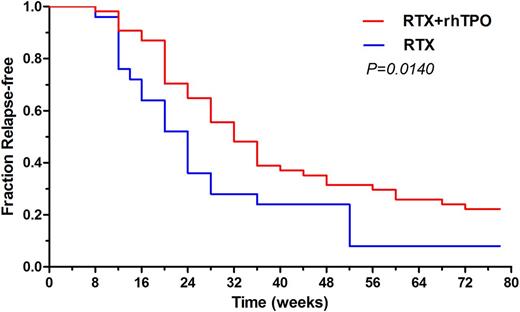Abstract
Though great progresses had been achieved in the management of primary immune thrombocytopenia (ITP), still 25%-30% of the patients show no response to the conventional therapy. Both thrombopoietin (TPO) and rituximab (RTX) are recommended as the second-line treatments. TPO has shown potent activity in ITP, but the therapeutic efficacy is dependent on continual administration. Rituximab is an anti-CD20 chimeric monoclonal antibody which could induce prolonged remission in ITP. However, longer time to response was also reported. The combination of rhTPO and rituximab could complement each other in both mechanism of action and time window, exert powerful effect, which may be a choice for the glucocorticosteroids-resistant/relapsed patients.
Patients with platelet counts ≤ 30 x109/L, or ≤ 50 x109/L with bleeding symptoms from 12 centers were enrolled in the study. Subjects enrolled in the study were assigned randomly as 1: 2 to RTX group and rhTPO plus RTX group. Eligibility criteria were set according to the recently published guideline (Rodeghiero F, et al, Blood 2009). Approval for the study was obtained from the Ethics Committee of the School of Medicine and Qilu Hospital. Informed consent in accordance with the Declaration of Helsinki was given to each patient.
Rituximab (MabThera; Roche) was given with a fixed dose of 100mg weekly for four weeks. And in the combination group, rhTPO (Tebiao, 3SBio, China) was added in the regimen with a dose of 300U/kg/day in the first 14 days, and a modified frequency of rhTPO was given according to the platelet counts after two weeks, but no longer than four weeks.
Primary outcomes include response (R), complete response (CR), no response (NR) and relapse. All the criteria were consent with the definition and outcome criteria. (Rodeghiero F, et al. Blood, 2009.) Secondary outcomes are listed below. Time to response (TTR) was considered as the duration from baseline to response. Time to relapse was also measured with Kaplan-Meier analysis. Besides, safety was reflected as adverse events graded according to the Common Toxicity Criteria. This clinical trial was registered at http://clinicaltrials.gov as NCT 01525836.
A total of 114 patients were recruited: monotherapy group (n = 35) and combination group (n = 79). All patients failed to response to glucocorticosteroids or relapsed after corticosteroids treatment. Response rate was reached in 71.4% (25/35) of patients in monotherapy group vs. 78.5% (62/79) in the RTX and rhTPO combination group, while complete responses were achieved as 10/35 (28.6%) in RTX monotherapy group and 34/79 (43.0%) in rhTPO plus RTX group respectively. Median time to response was 28 days (range 4-90 days) in RTX group, while in RhTPO plus RTX group, TTR was 7 days (range 4-28 days) (P = 0.002). There was significantly longer time to relapse in the combination group (shown in Fig. 1).
Characteristics and result of RTX group and rhTPO plus RTX
| parameter . | RTX (n = 35) . | rhTPO + RTX (n = 79) . | P value for difference between groups . | |
|---|---|---|---|---|
| Age, median (range) | 46(14-68) | 42(13-82) | .664 | |
| Female / Male (n) | 23/12 | 51/28 | .905 | |
| Baseline platelet count, median(range) | 13(3-36) | 8(0-32) | .221 | |
| OR, % | 71.4%(25/35) | 78.5%(62/79) | .414 | |
| CR, % | 0.286 | 0.43 | .143 | |
| NR, % | 28.6% | 21.5% | .414 | |
| TTR, day(s) | 28(4-90) | 7(4-28) | .002* |
| parameter . | RTX (n = 35) . | rhTPO + RTX (n = 79) . | P value for difference between groups . | |
|---|---|---|---|---|
| Age, median (range) | 46(14-68) | 42(13-82) | .664 | |
| Female / Male (n) | 23/12 | 51/28 | .905 | |
| Baseline platelet count, median(range) | 13(3-36) | 8(0-32) | .221 | |
| OR, % | 71.4%(25/35) | 78.5%(62/79) | .414 | |
| CR, % | 0.286 | 0.43 | .143 | |
| NR, % | 28.6% | 21.5% | .414 | |
| TTR, day(s) | 28(4-90) | 7(4-28) | .002* |
Kaplan-Meier plot of time to relapse in patients achieving response or complete response.
Kaplan-Meier plot of time to relapse in patients achieving response or complete response.
Adverse effects were observed in RTX group in 5 patients, most of whom were affected with inflammation. One patient was reported as viral myocarditis, and there were also complaints about chill, rash and hyperpyrexia. And incidence of adverse events was slightly increased in rhTPO plus RTX group. There were 14 adverse effects reported in the combination group, such as fatigue, pulmonary inflammatory, but all were below Grade 2.
Our findings suggest that combination of RTX and RTX in ITP yields shorter time to response compared with monotherapy of RTX, and moreover, combination extended time to relapse. Thus, combination therapy may represent an effective treatment option for glucocorticosteroids-resistant or relapsed patients.
The results were compared with Gehan-Breslow-Wilcoxon Test. (P = 0.0140)
No relevant conflicts of interest to declare.
Author notes
Asterisk with author names denotes non-ASH members.


This feature is available to Subscribers Only
Sign In or Create an Account Close Modal